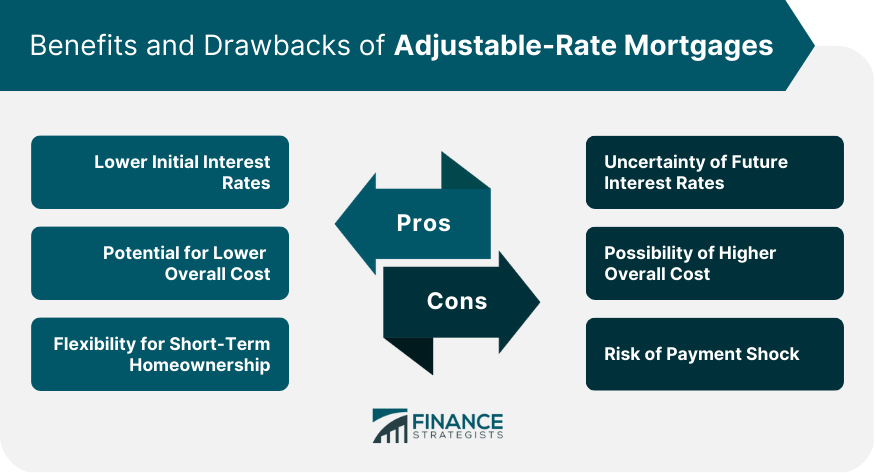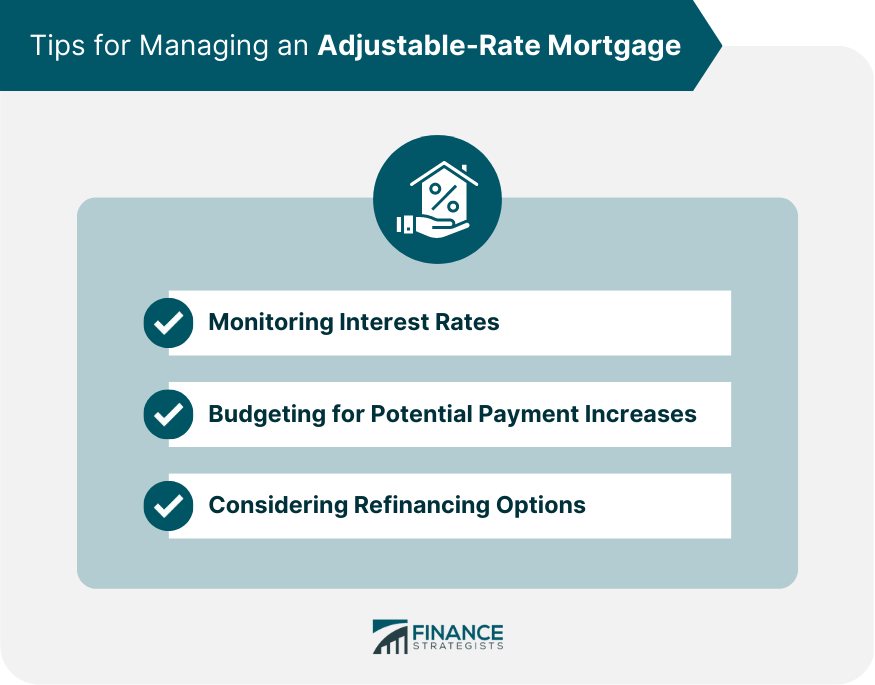Adjustable-rate mortgages (ARMs) are a type of home loan with an interest rate that changes periodically based on market conditions. The interest rate may increase or decrease over the life of the loan, affecting the borrower's monthly mortgage payment. Adjustable-rate mortgages can offer borrowers lower initial interest rates and the potential for lower overall borrowing costs, making them an attractive option for certain homebuyers, such as those with short-term homeownership plans or those expecting their income to increase over time. Hybrid ARMs combine features of both fixed-rate and adjustable-rate mortgages. They have an initial fixed-rate period, followed by an adjustable-rate period. Common hybrid ARMs include 3/1, 5/1, 7/1, and 10/1 ARMs, where the first number represents the length of the fixed-rate period in years, and the second number indicates the adjustment frequency in years after the fixed period ends. Interest-only ARMs allow borrowers to pay only the interest portion of their mortgage payment for a specified period, typically between 3 and 10 years. After the interest-only period ends, the loan converts to a fully amortizing adjustable-rate mortgage, which requires the borrower to make higher monthly payments that include both principal and interest. Payment-option ARMs offer borrowers multiple payment options each month, including a minimum payment, an interest-only payment, and a fully amortizing payment. These loans typically have a higher risk of negative amortization, where the loan balance increases over time because the minimum payments do not cover the full interest accrued. The initial interest rate is the starting rate on an adjustable-rate mortgage. This rate is typically lower than the rate on a comparable fixed-rate mortgage and remains fixed for a specified period before adjusting. The adjustment period is the frequency at which the interest rate changes on an adjustable-rate mortgage. Common adjustment periods include annually, semiannually, or monthly, depending on the terms of the loan. The index is a benchmark interest rate used to determine the adjustments to the mortgage interest rate. Common indices include the London Interbank Offered Rate (LIBOR), the U.S. Prime Rate, or the 1-year Constant Maturity Treasury (CMT) rate. The margin is a fixed percentage added to the index to determine the adjusted interest rate on an ARM. The margin remains constant throughout the life of the loan. Interest rate caps limit the amount that the interest rate can change during each adjustment period and over the life of the loan. Periodic caps limit the amount the interest rate can change during a single adjustment period. Lifetime caps limit the maximum interest rate that can be charged over the life of the loan, regardless of changes in the index. Adjustable-rate mortgages typically offer lower initial interest rates than fixed-rate mortgages, providing borrowers with a lower initial monthly payment. If interest rates remain stable or decrease over the life of the loan, borrowers with ARMs may pay less in interest than they would with a fixed-rate mortgage. ARMs can be an attractive option for borrowers who plan to sell their home or refinance within a few years, as the lower initial interest rate can result in significant savings during the initial fixed-rate period. Adjustable-rate mortgages carry the risk of interest rate fluctuations, making it difficult for borrowers to predict their future monthly payments. If interest rates increase significantly over the life of the loan, borrowers with ARMs may end up paying more in interest than they would with a fixed-rate mortgage. When the interest rate adjusts, borrowers may experience a significant increase in their monthly mortgage payment, leading to potential financial stress or difficulty making payments. When deciding between a fixed-rate and an adjustable-rate mortgage, borrowers should consider: Length of homeownership: If the borrower plans to sell or refinance within a few years, an ARM may be more cost-effective due to the lower initial interest rate. Risk tolerance: Borrowers who are uncomfortable with the uncertainty of fluctuating interest rates may prefer the stability of a fixed-rate mortgage. Financial stability: Borrowers with a strong financial foundation may be better equipped to handle potential payment increases due to interest rate adjustments. Current interest rate environment: In a low-interest-rate environment, fixed-rate mortgages may be more attractive, while adjustable-rate mortgages may be more appealing when interest rates are high or expected to decrease. Lenders typically require borrowers to have a good to excellent credit score to qualify for an adjustable-rate mortgage. The specific credit score requirements may vary by lender and loan program. Lenders will evaluate a borrower's debt-to-income (DTI) ratio to determine their ability to afford the mortgage payments. A lower DTI ratio indicates a stronger financial position and a higher likelihood of loan approval. Down payment and equity requirements for adjustable-rate mortgages may vary by lender and loan program. Generally, a larger down payment or more home equity can result in better loan terms and a lower interest rate. Borrowers with adjustable-rate mortgages should keep a close eye on interest rate trends and be prepared for potential changes in their monthly mortgage payments. It's essential for borrowers with ARMs to plan for the possibility of higher monthly payments due to interest rate adjustments. Creating a budget that accounts for potential payment increases can help borrowers avoid financial stress. If interest rates rise significantly or if the borrower's financial situation changes, refinancing to a fixed-rate mortgage or another adjustable-rate mortgage with more favorable terms may be a viable option. Having a solid understanding of adjustable-rate mortgages, including their unique features, benefits, and risks, is crucial for potential borrowers considering this type of home loan. By carefully evaluating their financial situation, risk tolerance, and homeownership goals, borrowers can make informed decisions about whether an adjustable-rate mortgage is the right choice for their specific circumstances. Comparing various mortgage options and seeking guidance from qualified professionals can help borrowers make the best choice for their individual needs and long-term financial goals.What Are Adjustable-Rate Mortgages?
Types of Adjustable-Rate Mortgages
Hybrid ARMs
Interest-Only ARMs
Payment-Option ARMs
Components of Adjustable-Rate Mortgages
Initial Interest Rate
Adjustment Period
Index
Margin
Interest Rate Caps
Periodic Caps
Lifetime Caps
Pros and Cons of Adjustable-Rate Mortgages
Pros
Lower Initial Interest Rates
Potential for Lower Overall Cost
Flexibility for Short-Term Homeownership
Cons
Uncertainty of Future Interest Rates
Possibility of Higher Overall Cost
Risk of Payment Shock

Choosing Between Fixed-Rate and Adjustable-Rate Mortgages
Factors to Consider
Qualifying for an Adjustable-Rate Mortgage
Credit Score Requirements
Debt-To-Income Ratio
Down Payment and Equity Requirements
Tips for Managing an Adjustable-Rate Mortgage
Monitoring Interest Rates
Budgeting for Potential Payment Increases
Considering Refinancing Options

Conclusion
Importance of Understanding Adjustable-Rate Mortgages
Making Informed Decisions on Home Financing Options
Adjustable-Rate Mortgages FAQs
An adjustable-rate mortgage (ARM) is a type of mortgage loan in which the interest rate can change over time. The interest rate on an ARM is usually lower than a fixed-rate mortgage at the beginning of the loan term, but the rate can fluctuate based on changes in the market.
An adjustable-rate mortgage typically has an initial fixed-rate period of 3, 5, 7, or 10 years, during which the interest rate is fixed. After the initial period, the interest rate can adjust up or down based on a specific index, such as the LIBOR or Treasury rates, plus a margin determined by the lender.
The primary advantage of an adjustable-rate mortgage is that it typically has a lower interest rate and monthly payment in the initial period than a fixed-rate mortgage. This can make the loan more affordable for borrowers who plan to sell or refinance before the rate adjusts.
The primary risk of an adjustable-rate mortgage is that the interest rate and monthly payment can increase significantly after the initial fixed-rate period. This can make the loan less affordable for borrowers and can lead to financial stress or default.
An adjustable-rate mortgage may be suitable for borrowers who plan to sell or refinance before the rate adjusts or those who expect their income to increase in the future. It may not be suitable for borrowers who plan to stay in the home long-term or those who are on a fixed income and may not be able to afford an increase in the monthly payment. It is important to consider your financial goals and circumstances when deciding if an ARM is right for you.
True Tamplin is a published author, public speaker, CEO of UpDigital, and founder of Finance Strategists.
True is a Certified Educator in Personal Finance (CEPF®), author of The Handy Financial Ratios Guide, a member of the Society for Advancing Business Editing and Writing, contributes to his financial education site, Finance Strategists, and has spoken to various financial communities such as the CFA Institute, as well as university students like his Alma mater, Biola University, where he received a bachelor of science in business and data analytics.
To learn more about True, visit his personal website or view his author profiles on Amazon, Nasdaq and Forbes.















